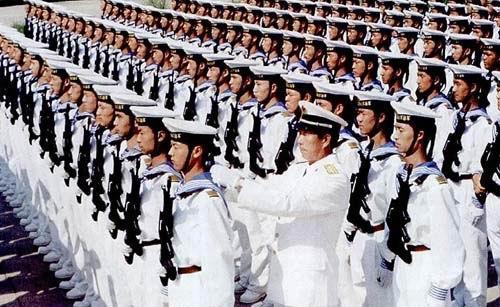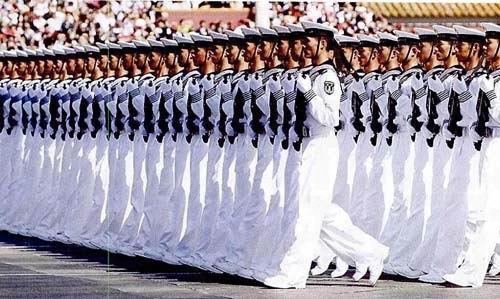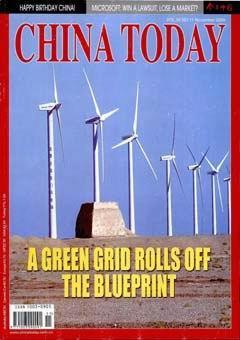A Military Parade Veteran
By staff reporter ZHANG MAN


Since the establishment of the PRC 60 years ago, the country has held 14 National Day military parades. Sun Qihua not only participated as a young solider in two of those early parades, but also later became the team leader and head coach of the naval troops during the 1984, 1999 and 2009 parades.
“I Saw Chairman Mao”
Sun Qihua enlisted in the marines in 1956. The 17-year-old seaman could not have foreseen that he would one day have such a long and close relationship with Chinas biggest military parades.
A National Day military parade was held every year during the 1950s. However, common people rarely had the chance to see this grand ceremony since television was inaccessible at the time.
For this reason, Sun Qihua and his counterparts were extremely excited when enrolled in the Navys parade formation for the 1958 National Day celebration. “It meant that I would have a chance of seeing Chairman Mao in Tiananmen Square!” Sun recalls.
The 181-cm-high Sun Qihua made it through the strict selection process thanks to his impressive height – one that helped him to stand out among the 200 soldiers in his company.
The news was well received in Suns hometown where everybody was proud of him. His parents, simple farmers unable to read or write, asked others to pen letters to their son, encouraging him to work hard and bring honor to his hometown, his company and his country.
The select soldiers were trained in the countryside near Longkou, Shandong Province. No special training area was set aside for them, simply a patch of razed farmland. When the rainy season hit, the dusty farmland quickly turned into a muddy field, but no one complained about the poor conditions. The soldiers patriotism and toughness still impress Sun to this day. “We all focused on training and looked forward to the big moment.”
The moment finally came on the morning of October 1, 1958. Standing in the naval formation, Sun Qihua was in the closest proximity of his life to state leaders Mao Zedong, Liu Shaoqi, Zhou Enlai and Zhu De. “I could have seen them as long as I lifted my head, but I resisted the urge out of fear that it might disturb the orderly formation.” Sun is still excited when talking about his first parade. He remembered, “My mind went blank when marching in front of the Tiananmen Gate.”
But facing his ardent comrades in arms upon his return from Beijing, Sun Qihua didnt have the heart to tell them the truth. He could only say that he had “seen” Chairman Mao.
Twenty-five Years of Waiting
Owing to their marvelous performance, Sun Qihua and his fellow company men were again enrolled in the formation of the National Day parade the following year. Only this time, Sun stood in the second row of the array, which meant he was getting closer to the rostrum.
With his previous experience under his belt, Sun didnt feel as nervous as before and seized the chance to steal a peek at the top leader.
In 1960, Sun Qihua was selected for a third time. Each team member trained as hard as before, leading the naval array to win first prize during the rehearsals. But to everyones shock, the military parade was canceled just a few days before National Day.
From 1959, severe natural disasters hit China, subjecting the country to famine for three consecutive years. Under these circumstances, the central government decided to constrict the annual military parades to “smaller celebrations to take place every five years and larger events every ten years.” Nevertheless, the parades were not reinstated again until 1984.
Like other Chinese people of that generation, Sun Qihua faced all the various political movements that took place during that 20-year period, but never left his beloved naval force.
Peaceful, Civilized and Mighty
The central government decided to once again hold a grand celebration for the 35th National Day.
Sun Qihua had patiently waited 25 years for this moment. In 1984, the 44-year-old veteran was made head coach of the naval formation. He took the lead position, guiding his troops past the Tiananmen Rostrum.
At that very moment, villagers in his hometown were gathering to watch the parade on TV, and they were overcome with tears as they saw Sun Qihuas figure appear. Deng Xiaoping, then chairman of the Central Military Commission, was moved to issue an order of commendation to the naval array for their outstanding performance.
In 1999, for the military parade commemorating the nations 50th anniversary, Sun Qihua, retired by then, was invited once again to fulfill the role of head coach for the naval array. Throughout the summer, Sun Qihua and his soldiers withstood the scorching sun and burning heat, practiced their formation drills and marched every day. Sun did not personally participate in the parade himself, yet he still felt tremendous pride and joy watching his men march with pinpoint precision and invincible gallantry across the Tiananmen Square. This time, the naval formation once again received awards from the Central Military Commission.
From the 1950s onwards, when he was carried by Soviet trucks through the square during the parade, till today, when domestically produced cutting-edge ordnance are stealing the show, the veteran acquired a deeper understanding of the parade itself: presenting to the entire nation and the world the great achievements in Chinas national defense and military modernization is the heart of the matter.
“The Military parade is more than a ceremony, a formality in itself; more importantly, it embodies the spirit of the military and the nation. The parade is also an exhibition, where Chinese military forces – the ‘peaceful, civilized and mighty army –embodies the resolution with which China defends state security, the interests of development and world peace. At the same time, it boosts Chinese peoples patriotism,” Sun says. “For us, our sweat, even our pain, in comparison with the spiritual heights gained, is really negligible.”
1989 - Sino-Soviet relations normalized
- political disturbance occurred around late spring and early summer.
1990 - commitment to develop Pudong New Area and founding of the Shanghai Stock Exchange

